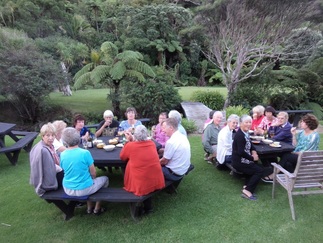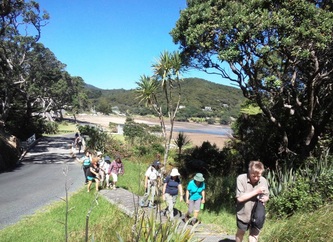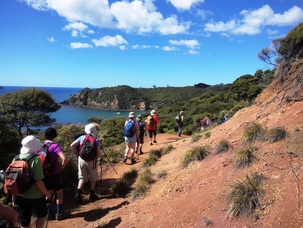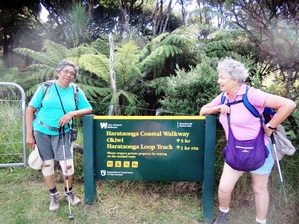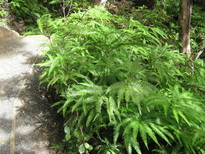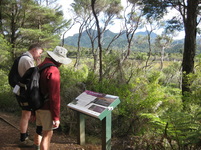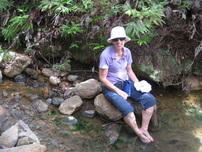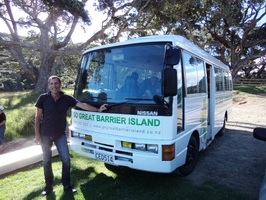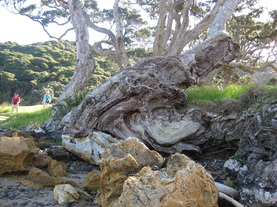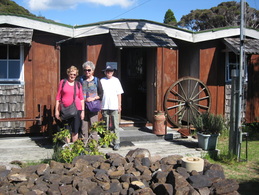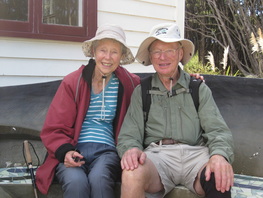Trip Report - Great Barrier Island
Easter 2015
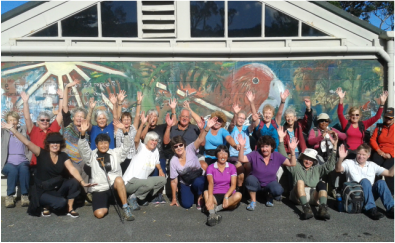 Who wouldn't be happy on Great Barrier?
Who wouldn't be happy on Great Barrier?
Blue skies, warm sun and sparkling seas - perfect for our early morning ferry sailing to Tryphena on Great Barrier Island. With our luggage stowed we settled in for the four and a half hour journey to this beautiful island that is now part of Auckland but feels a million miles away. (No public transport and residents generate their own power).
Our very congenial driver, Steve, welcomed us at Tryphena Wharf and transported us to our beachfront accommodation. Our first afternoon on the Barrier was spent walking the local Miller's Hill Track. Starting with a climb through native bush then a descent along local roads, we paused at the Gooseberry Flat historic cemetery where many of the pioneer families are buried. Our walk back was via the lovely beaches where, as it was low tide, we could explore magnificent caves and admire the ancient pohutukawas clinging to the cliffs.
Back at our villas it was time for a cuppa and we realised we were on Barrier time - we had to be patient while the kettle boiled on the gas stovetop (no electric jugs). A little later we relaxed over Happy Hour beside a stream with resident native eels,the odd banded rail poking about, and a bush backdrop, then even later it was time for dinner at a local café with equally lovely seaviews. Thank you Anne for spoiling us with the yummy dessert treats you made.
Harataonga Coastal Walkway - Day Two
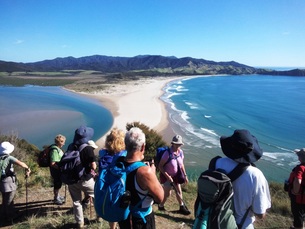 Overlooking Whangapoua Estuary
Overlooking Whangapoua Estuary
Day Two and we were off to do a stunning walk on the north-east coast of Aotea, Great Barrier. The Harataonga Walkway is high above the coast with panoramic views of white, sandy bays and elsewhere bush reaching right down the cliffs to the sea. Originally a bridal track cut to give access to Okiwi and Port Fitzroy, it was abandoned when the road was put through the centre of the island in the 1940s. Now restored, the track threads its way through thick kanuka and manuka bush, tree daisies (unfortunately no longer in flower), tangle ferns and the ever present invasive Hakea, a spiky Australian import which is also a big problem in South Africa and parts of Europe
It was hot and sunny again but an easy grade walk with just a couple of muddy patches and small stream crossings. It was good to see work being done to maintain the track to a pretty good standard.
Six hours after we started we arrived at Harataonga campsite with time to spare before our bus pickup. Some went exploring down to the beach, Pateke (brown teal duck) spotting, swimming or just relaxing.
Another happy hour in the open air was followed by dinner prepared by club members. Big thanks to Bev and helpers for the apple and blueberry crumble and custard!
With darkness falling and having the gift of an extra hour in the day due to the end of daylight saving, it was suggested we do a night trail in the DOC Te Rangitawhiri Reserve close by. Hopeful of spotting the nocturnal Pateke ducks or anything else interesting that was moving, a handful of us set off with torches. Sadly no interesting fauna was seen but the starry sky was lit by a full moon and John gave us an impromptu astronomy lesson so at least some of us returned less ignorant about the night sky! Thank you John.
It was hot and sunny again but an easy grade walk with just a couple of muddy patches and small stream crossings. It was good to see work being done to maintain the track to a pretty good standard.
Six hours after we started we arrived at Harataonga campsite with time to spare before our bus pickup. Some went exploring down to the beach, Pateke (brown teal duck) spotting, swimming or just relaxing.
Another happy hour in the open air was followed by dinner prepared by club members. Big thanks to Bev and helpers for the apple and blueberry crumble and custard!
With darkness falling and having the gift of an extra hour in the day due to the end of daylight saving, it was suggested we do a night trail in the DOC Te Rangitawhiri Reserve close by. Hopeful of spotting the nocturnal Pateke ducks or anything else interesting that was moving, a handful of us set off with torches. Sadly no interesting fauna was seen but the starry sky was lit by a full moon and John gave us an impromptu astronomy lesson so at least some of us returned less ignorant about the night sky! Thank you John.
Kaitoke Hot Springs and Te Ahumata Track - Day Three
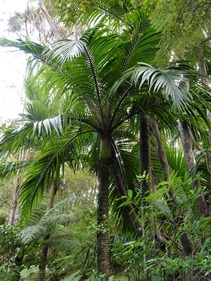 Nikau on Great Barrier are especially vigorous.
Nikau on Great Barrier are especially vigorous.
Kaitoke Hot Springs was the track we couldn't possibly leave out of our plans. Evidence of the horrendous storms of last winter met us when we had walked a short way in. However it was good to see that the very robust and vigorous form of Nikau that grows on Great Barrier had survived. With its drooping fronds and slimmer bulbs than the mainland Nikau, it is rather distinctive and very attractive.
The walk in to the pools was easy, part of it on boardwalks and alongside the Kaitoke wetlands, and we had plenty of time to walk slowly and "botanise". John and Sharleen studied two types of fern, Tangle Fern (Gleichenia dicarpa) and Umbrella Fern (Sticherus flabellatus), noted the differences and learnt how to tell them apart. We were, as always, pleased to see evidence of the lack of predators in the area - young kahikatea and miro were observed along this popular track.
At the pools we dipped our feet, joining others who were either local residents or weekend visitors. There is a good information board explaining how the water becomes heated by the rocks and describing how the club mosses (Lycopodium cernuum) like to have warm feet and thrive near the hot springs.
There were other short tracks nearby and, after exploring some of them, we returned to Whangaparapara Road to be picked up by the bus after re-spraying our boots against kauri dieback with Trigene solution.
The walk in to the pools was easy, part of it on boardwalks and alongside the Kaitoke wetlands, and we had plenty of time to walk slowly and "botanise". John and Sharleen studied two types of fern, Tangle Fern (Gleichenia dicarpa) and Umbrella Fern (Sticherus flabellatus), noted the differences and learnt how to tell them apart. We were, as always, pleased to see evidence of the lack of predators in the area - young kahikatea and miro were observed along this popular track.
At the pools we dipped our feet, joining others who were either local residents or weekend visitors. There is a good information board explaining how the water becomes heated by the rocks and describing how the club mosses (Lycopodium cernuum) like to have warm feet and thrive near the hot springs.
There were other short tracks nearby and, after exploring some of them, we returned to Whangaparapara Road to be picked up by the bus after re-spraying our boots against kauri dieback with Trigene solution.
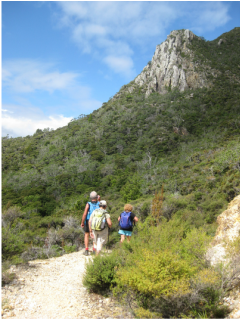 The White Cliffs - Te Ahumata Track
The White Cliffs - Te Ahumata Track
The Te Ahumata Track runs between Whangaparapara Road and Blind Bay Road along an old mining route. The climb at the start is gentle and carries on for about half an hour in undulating fashion. The most striking vegetation at the start is the invasive Hakea which we had seen on the Harataonga Walkway yesterday. The young trees look quite elegant with long tapering leaves, not at all like the ugly, spikey bushes they become. We knew that an endemic orchid was also to be found along this track, so we kept a look out for Orthoceras nova zeelandiae. We had seen many in flower in January, but hardly any were left by Easter. Another "find" was a relative of the Grass Tree, Dracophyllum patens.
The Te Ahumata Track is made for groups and families to experience. When you have climbed up beyond the turnoff to the summit track , which is not as fearful as it looks, the picnic table invites you to stop, have a bite to eat and enjoy the views over Blind Bay. From there its almost all downhill. We also encountered a small tree that looked like the Celery Pine and discovered that they are related, both are phylloclads. Toatoa (P. glaucus) also has the "stems" which are really flattened midribs of leaves.
On completion of our walk we were thrilled when our driver offered to drive us down to Okupu Bay (Blind Bay) where he showed us giant old pohutukawa including a "natural work of art", a photographer's delight.
The Te Ahumata Track is made for groups and families to experience. When you have climbed up beyond the turnoff to the summit track , which is not as fearful as it looks, the picnic table invites you to stop, have a bite to eat and enjoy the views over Blind Bay. From there its almost all downhill. We also encountered a small tree that looked like the Celery Pine and discovered that they are related, both are phylloclads. Toatoa (P. glaucus) also has the "stems" which are really flattened midribs of leaves.
On completion of our walk we were thrilled when our driver offered to drive us down to Okupu Bay (Blind Bay) where he showed us giant old pohutukawa including a "natural work of art", a photographer's delight.
Claris - Day Four
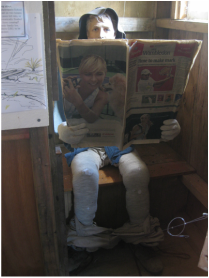 The man in the dunny!
The man in the dunny!
Our last day was spent exploring Claris, the main centre on Great Barrier. The first stop was the fascinating Milk, Honey and Grain Museum with its collection of imaginatively presented photographic stories and artifacts from the island's past. Accounts of the two famous shipwrecks, tales of the pigeon post, whaling and kauri logging days and stories of pioneer families were in part familiar to us from listening to our driver, Steve, and his stories. There were loud shrieks when the "dunny" door was opened to reveal the "occupant" lowering his newspaper and peering over the top!! (see photo)
We also visited the Art and Craft Gallery and supported the local craftspeople with some inspired souvenir shopping! A leisurely lunch at local cafes followed and a wander back to the i-site and airport where we watched the comings and goings of the small planes while we waited for our bus pick-up.
The end of our trip was in sight as we boarded the 3pm SeaLink ferry back to Auckland, but there was another unexpected treat in store: a group of playful dolphins, like quicksilver at the bow of the boat, thrilled us all as they led the way through the water. Then as night fell and we approached Auckland, the lights and flares of the waterfront and the electric blue of the Harbour Bridge display shone through the darkness. For some it was the first time we had seen our stunning harbour and city this way and it was an emotional experience.
We were back from Great Barrier but at least some of us have promised ourselves we will be returning!!! There are more tracks to walk and sights to see.
Thanks to Praemi, Molly and Sharleen for organising our "island getaway" and to Anne and Bev for their help.
We also visited the Art and Craft Gallery and supported the local craftspeople with some inspired souvenir shopping! A leisurely lunch at local cafes followed and a wander back to the i-site and airport where we watched the comings and goings of the small planes while we waited for our bus pick-up.
The end of our trip was in sight as we boarded the 3pm SeaLink ferry back to Auckland, but there was another unexpected treat in store: a group of playful dolphins, like quicksilver at the bow of the boat, thrilled us all as they led the way through the water. Then as night fell and we approached Auckland, the lights and flares of the waterfront and the electric blue of the Harbour Bridge display shone through the darkness. For some it was the first time we had seen our stunning harbour and city this way and it was an emotional experience.
We were back from Great Barrier but at least some of us have promised ourselves we will be returning!!! There are more tracks to walk and sights to see.
Thanks to Praemi, Molly and Sharleen for organising our "island getaway" and to Anne and Bev for their help.
